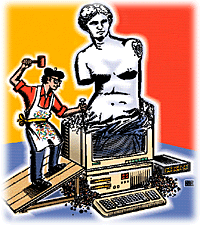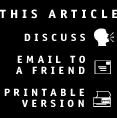 |
|
|
 On the Net, Through the Air, In Your Hands: Cellular Technology
and the Future of the Internet On the Net, Through the Air, In Your Hands: Cellular Technology
and the Future of the InternetBy Janet Perry janetp@napanet.net As a commercial running on a local radio station reminds me, cell phones used to cost several hundred dollars -- now they are giving them away. As cellular technology becomes more common, the cell could become a hand-held Internet station, making the power of the Internet available to people in many places & occupation where hard-wired connections won't work. At the Web'97 Developers Conference in February, Unwired Planet, a San Francisco Bay Area-based company, demonstrated an open standard for writing Web pages viewable on the four line screens of some high-end portable phones. Their technology connects these wireless phones directly to the Internet using RSA encryption. The connections are handled by the cellular phone companies which run a gateway providing protocol translation, compression, security, accounting and administration. The gateway compensates for these devices which don't have the capacity to speak TCP/IP. Each service provider will have a gateway, a Web server, and an e-mail server available. The phones can link into either the Internet or a private intranet, and are notifies of mail using a 9600-baud link. The phone is always attached to the network, using a protocol called CDPD (cellular digital packet data). Because this is not an active cellular connection, it does not effect either the use of the phone as a phone or the size of your phone bill. Each phone is equipped with a small browser, an e-mail package, and a personal information manager. The browser will also synchronize information with a desktop PC or Mac. The browser technology uses a new standard, HDDL, which displays data on a 4 twenty-character lines. It does not support graphics (except old-style ASCII-graphics), and really doesn't have context (their tests have found that scrolling tends to confuse users). The display area is about 1/64th of a VGA screen. Currently a draft RFC on this standard is going to the W3 Committee. While currently this protocol is only supported in cell phones, it can also be used for pagers, cellular ID boxes, and display equipped phones, making them all virtual Internet nodes. For a Web-page developer this use of cellular technology opens up new uses for existing data. Developers do not need to directly support this technology, but instead need to add special code to support the smaller, no-graphics display. These tags are gathered together in a simple set of protocols called HDML (Hand-held Device Mark-up Language). HDML is a simple language which treats data as sets of 4x20 "cards". The gateway sends several cards at once to overcome the latency of the network for smoother processing. Web designers and developers create hybrid sites by adding HDML tags to provide an alternative view of their existing pages. HTML provides the interface for the desktop while HDML provides the smaller screens for the faster access phones. User actions on the cell phone trigger HTTP requests which are answered by sending the HDML code. While most applications will expand easily to include this new data, in some cases new data entry will need to be provided. Text-based data can be displayed and a certain level of interactivity is supported, creating predictable ways for applications within the system to work. This reduces greatly the amount of new information each content provider needs to include, making it similar to the standard ways all ATMs work, no matter where they come from. Information can be displayed, users can enter data, or they can make a choice from a menu. Surprisingly, a good bit of information can be displayed and used with so few commands. For example, UPS and FedEx currently offer HDML support for their package tracking. I call up the FedEx application, for example, and enter the tracking number. Much in the same way FedEx's Web interface works, information about my package will be displayed on my phone's data screen. I can also check on flights from United Airlines, and other useful information like restaurant guides, and, in the future hotel and car reservations. For e-mail, only the first 200 characters of the message are sent to the phone. The user can request "more" information and attachments are not displayed. However, a fax option is always available to allow the entire message to be sent as a fax. Today's user of cellular phone internet is the mobile professional, over 30 with an income of more than $75,000 per year. These users are PC & Internet savvy and spend hundreds of dollars on cellular per year. Although today's potential users of this technology are the high-end users, by 1998 these phones will be within the reach of many consumers. As the cost of Internet-capable phones drops, this technology will really come into the fore, replacing other pencil and paper, and data entry functions for dispatch, delivery, and other "blue-collar" applications. For example, a cable TV installer can download interact with his office after each appointment to determine which appointment to go to next. Once he has made his choice, the office is notified and the homeowner is called to expect the appointment. Utility meter readers can enter the data directly into their phone where it is immediately used to update the customer tracking system, instead of waiting till the end of the day for a download. By using this technology, routes can be planned efficiently, information can be updated in real time, saving companies time and money. Cell phone internet can be a real benefit for developers as well. Currently, interface with this network makes sites more visited, and opens up Web sites to high-end channels for sales and marketing. The best place for finding ideas for these applications are the current information uses of alphanumeric pagers: stock quotes, sports scores, breaking news headlines, etc. All in all, the addition of cellular phones to the Internet provides
another way to use and leverage data for leveraged individuals.
As the technology becomes more widely available, then more and
more of us will find yet another use for the phones in our cars. |

